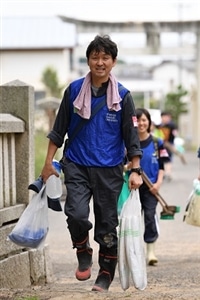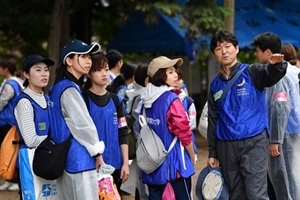
Service Learning
Once again, this summer, the Japanese archipelago was beset by numerous natural disasters, including earthquakes, typhoons, and torrential rains. While it is now possible to predict these disasters to a certain extent, communities in the affected areas have been destroyed, and many victims, while their lives may have been spared, have lost the foundations of their daily lives. Just over 23 years have passed since the Great Hanshin-Awaji Earthquake of 1995, which took the lives of almost 6,500 people. Hundreds of volunteers flocked to the affected region to assist after the earthquake, and that year can almost be described as “Year One of the Volunteer” in Japan. Volunteer activities and assistance have become essential to post-disaster recovery.
While continuing to support disaster-affected regions, Professor Yoshihiro Seki of the School of Sociology is researching the deepest layers of civic society in which people support each other and interact with each other, from the perspective of volunteerism. From August into September, as an activity of the Human Services Support Office, Professor Seki escorted groups of students, faculty and staff three times to Mabi-cho in the city of Kurashiki, Okayama Prefecture, which was hit particularly hard by the torrential rains that struck western Japan early in the summer. Working up a sweat together with the group, digging up mud and clearing up furniture, Professor Seki listened to what the affected residents had to say. The Human Services Support Office also remains active in the areas affected by the Kumamoto earthquake of 2016. In addition to his work with the Support Office, Professor Seki also continues to travel to other areas affected by floods and earthquakes, including the village of Noda in Iwate Prefecture, the city of Ojiya in Niigata Prefecture, and the town of Sayo in Hyogo Prefecture, with his seminar group and other volunteer-based activities. He also assists with gatherings of people affected by the Great East Japan Earthquake living outside the prefectures, which are organized by a Nishinomiya non-profit organization (NPO) and the Social Welfare Council, and in urban renewal projects in Amagasaki’s Muko district. Areas affected by disasters, and the fields in which residents and others are taking action themselves, are his research locales.

In August 2009, the year that Professor Seki came to work at Kwansei Gakuin University, typhoon-induced flooding in the town of Sayo in Hyogo Prefecture resulted in many casualties. This was just after he had started to set up disaster-readiness education programs aimed at children in collaboration with a local NPO. Prof. Seki took a group of students, including those from his seminar group, to the affected areas, and also continued to travel to settlements in the city of Ojiya in Niigata Prefecture that been damaged in the 2004 Chuetsu Earthquake. Then, in March 2011, the Great East Japan Earthquake struck. About two weeks after the earthquake, Prof. Seki took a group of students to the town of Higashi- Matsushima in Miyagi Prefecture, traveling there and back on the same day. This was when he started to become involved in disasters in earnest as research fieldwork. Later, he moved the base of his work in the East Japan affected areas to the village of Noda in Iwate Prefecture, and he has continued to make multiple trips there to assist people living in temporary housing. The work demanded of volunteers starts with clearing rubble and removing other visible hazards in the initial stages after the disaster. Then, after a certain amount of time has elapsed, it starts to revolve around forging relationships and supporting the local residents. Volunteerism is seen as an activity based on free, arbitrary choices. Faced with something that has happened before one’s eyes, one starts from the feeling of wanting to do something, even if one does not have a strong sense of mission. It is important to act as one wants, as that will lead to the power to change society.
As Prof. Seki explains, “It is important not to think of volunteerism, but to think from volunteerism. I tell my students to keep notes (field notes) of what they are feeling when they are on the ground in the affected areas. This is so they can give as much thought as possible to what the society that they are engaging with should look like and to put those thoughts into words. As they make repeat visits to the same area, the locals start to remember the students’ names. Students genuinely feel ‘happy’ when this happens, but I make them think about where that feeling is coming from, and to think about the substance of that word ‘happy.’ It’s a different feeling from being ‘happy’ when one receives a gift of money, for example. This is an experiment in verbalizing and visualizing the thoughts and feelings that the students have in their engagement with the disaster-affected areas. “When we travel to these areas repeatedly and listen to what the residents have to say, there is one thing that becomes quite clear. Being affected by these kinds of disasters means that those things that had once been ‘normal’ for these people, which they had built up over a long period, such as their families, their homes, and their daily lives, have collapsed (their fundamentals of existence).

"Eventually, some of these victims start to think that there is no point in continuing to try, and that there is nothing they can do. How should volunteers who have come from outside interact with victims who have started to feel this way? How do we help them to recover that “normal” that used to be so obvious? In answer to that question, I believe that it is important to keep visiting those areas and to make connections. If a visit is not possible, even writing a letter would suffice. For example, as we have traveled to the same areas every year, the affected residents can see how the students have grown and become stronger year by year. We have seen that the students’ activities and engagement have the potential to provide the momentum for the people affected to recover their own “normal.” “On the other hand, some concerns have emerged as volunteerism has become more popular and common. A stereotypical image of a volunteer has started to spread and there are people who aim to achieve that image or to take advantage of it in some way. The table released by the Tokyo Olympics organizers of the required number of volunteers is another example. In the Human Services Support Office, rather than how many volunteers we have and how well they perform, we consider what the students can and cannot do as volunteers according to each individual situation, and we place value in what the students can learn from volunteerism."
